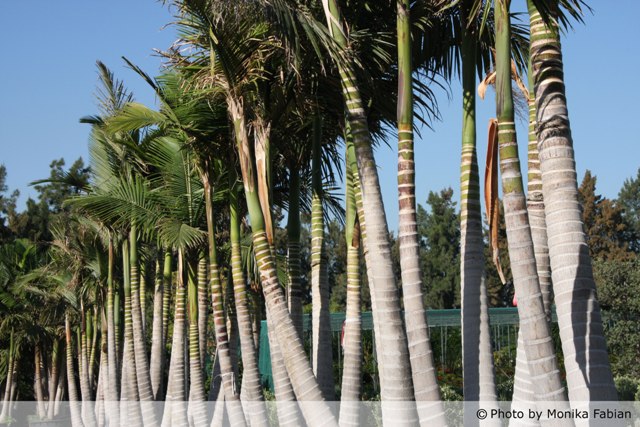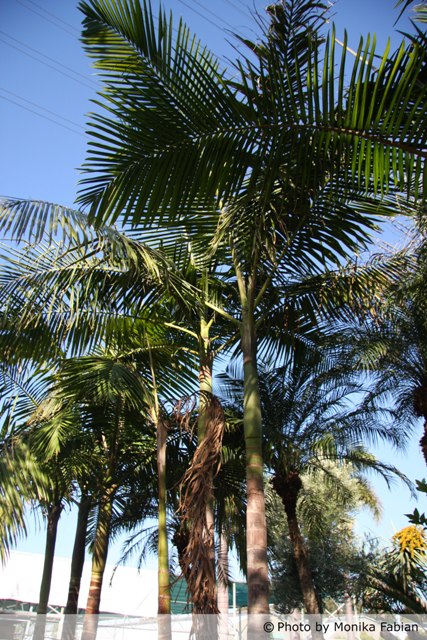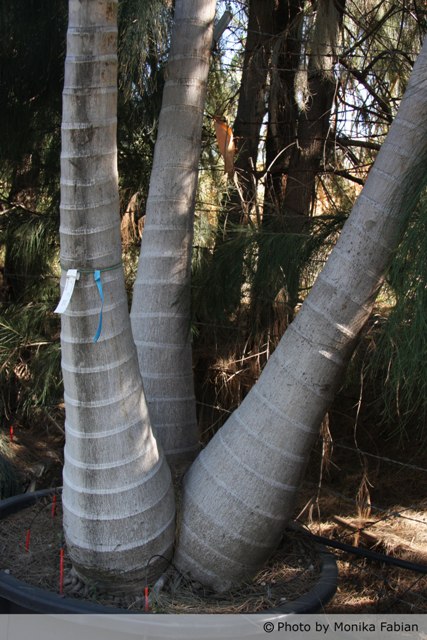Archontophoenix alexandrae (Alexandra Palm)
Archontophoenix alexandrae is a tall palm, about 25 metres tall with a spread of about 2 meters. The leaves have a tendency to rotate 90 degrees to expose the whole leaf in profile, The base of the petioles form a bright breen crownshaft that the leaves rarely droop below. The trunk is smooth and ringed with noticible leaf scars and the base can be noticibly swollen. Flowers are creamy flower stalks holding amythest purple flowers. The round fruit turn bright red at maturity. They do like more water than most palms, with some even thriving in poorly drained areas. It is quite a fast grower, averaging about 1/3 - 1 meter per year.
- Landscape Information
- Botanical Description
- Horticulture Management
-
-
By Dave Kimble (Own work) [CC-BY-SA-3.0 (http://creativecommons.org/licenses/by-sa/3.0)], via Wikimedia Commons
-
By Dave Kimble (Own work) [CC-BY-SA-3.0 (http://creativecommons.org/licenses/by-sa/3.0)], via Wikimedia Commons
-
-
-
By Kahuroa (Own work) [Public domain], via Wikimedia Commons
Search plant on Google
Download as PDF
-
French Name: Palmier royal
Pronunciation: ar-kawn-toe-FEE-nicks al-leck-SAN-dree
-
Plant type: Palm
-
Origin: Australia
-
Heat Zones: 1 to 12
Hardiness Zones: 10 to 11
-
Uses: Specimen, Mass Planting, Indoor, Container, Pollution Tolerant / Urban
-
Size/Shape
Growth Rate: Fast
Tree Shape: Palm
Canopy Symmetry: Symmetrical
Canopy Density: Open
Canopy Texture: Fine
Height at Maturity: 5 to 8 m
Spread at Maturity: 3 to 5 meters
-
Notes
Alexandra palm is a popular landscape specimen but is difficult to transplant; the bud must be protected when moving
-
-
By Dave Kimble (Own work) [CC-BY-SA-3.0 (http://creativecommons.org/licenses/by-sa/3.0)], via Wikimedia Commons
-
By Dave Kimble (Own work) [CC-BY-SA-3.0 (http://creativecommons.org/licenses/by-sa/3.0)], via Wikimedia Commons
-
-
-
By Kahuroa (Own work) [Public domain], via Wikimedia Commons
Search plant on Google
Download as PDF
-
Foliage
Leaf Arrangement : Spiral
Leaf Venation: Parallel
Leaf Persistance: Evergreen
Leaf Type: Odd Pinnately compund
Leaf Blade: Over 80 cm
Leaf Shape: Linear
Leaf Margins: Entire
Leaf Texture: Leathery, Fine
Leaf Scent: No Fragance
Color(growing season): Green
Color(changing season): Green
-
Flower
Flower Size Range: 10 - 20
Flower Type: Spike
Flower Sexuality: Monoecious (Bisexual)
Flower Scent: No Fragance
Flower Color: Yellow, White
Seasons: Summer
-
Trunk
Trunk has Crownshaft: Yes
Trunk Susceptibility to Breakage: Suspected to breakage
Number of Trunks: Single Trunk
Trunk esthetic Values: Smooth, Colored
-
Fruit
Fruit Type: Berry
Fruit Showiness: Yes
Fruit Size Range: 1.5 - 3
Fruit Color: Red
Seasons: Summer
-
-
By Dave Kimble (Own work) [CC-BY-SA-3.0 (http://creativecommons.org/licenses/by-sa/3.0)], via Wikimedia Commons
-
By Dave Kimble (Own work) [CC-BY-SA-3.0 (http://creativecommons.org/licenses/by-sa/3.0)], via Wikimedia Commons
-
-
-
By Kahuroa (Own work) [Public domain], via Wikimedia Commons
Search plant on Google
Download as PDF
-
Tolerance
Heat Tolerance: Yes
Salt Tolerance: Moderate
-
Requirements
Soil Requirements: Clay, Loam, Sand
Soil Ph Requirements: Acidic, Neutral
Water Requirements: High
Light Requirements: Full, Part
-
Management
Toxicity: No
Susceptibility to Pests and Diseases: No
Pruning Requirements: No pruning at all
Fruit/ Leaves/ Flowers litter: No
Life Span: 25-50 years
Plant Propagation: Seed



